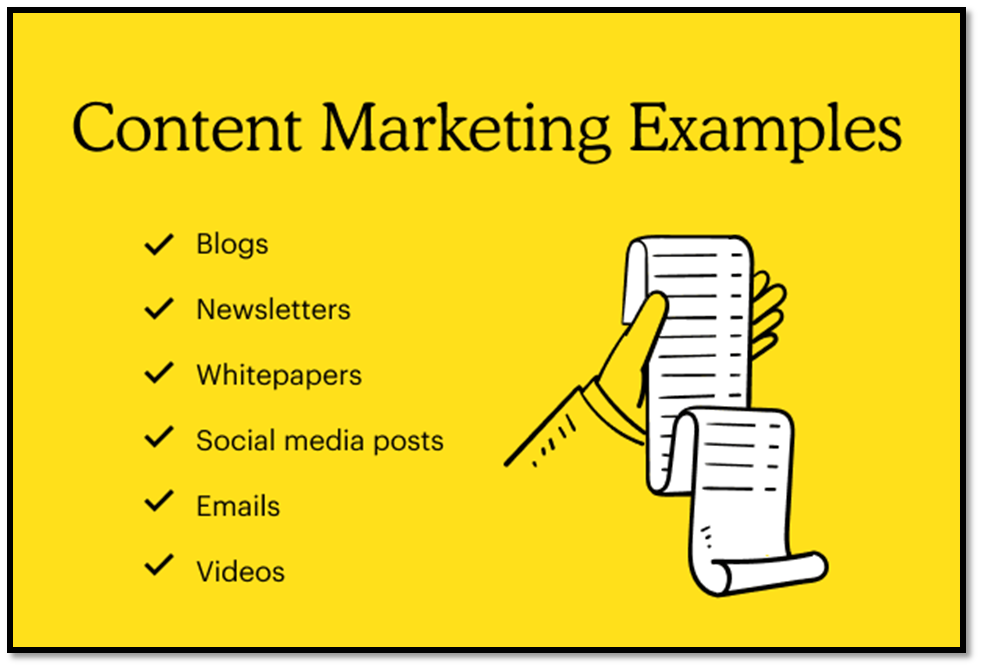
TYPES OF DIGITAL MARKETING
There are so many types in digital marketing.Some of them are:
1.CONTENT MARKETING
Moreover, content marketing helps businesses stay top of mind when customers are ready to make a purchase. By consistently delivering valuable content, businesses can establish themselves as trusted authorities in their industry. When the audience is ready to buy a product or service related to the content they’ve consumed, they are more likely to turn to the business that provided them with valuable information.
- Businesses with blogs get 67% more leads than other companies.
- 72% of business to business (B2B) marketers say content marketing increases engagement and the number of leads they generate.
- 88% of people credit branded videos for convincing them to purchase a product or service.

2.SEARCH ENGINE OPTIMIZATION
SEO means Search Engine Optimization and is the process used to optimize a website’s technical configuration, content relevance and link popularity so its pages can become easily findable, more relevant and popular towards user search queries, and as a consequence, search engines rank them better.
Keyword research is an essential aspect of SEO, as it involves identifying the most relevant and popular search terms that users are likely to use when looking for information or products related to a business. By strategically incorporating these keywords into the website’s content, headings, titles, and metadata, SEO helps search engines understand the website’s relevance to specific search queries.
ROLE OF SEARCH ENGINE
- INFORMATION RETRIVAL
- CONTENT DISCOVERY
- TRAFFIC GENERATION
- BRAND EXPOSURE
- MOBILE FRIENDLY
- SECURITY
Information Retrieval: Search engines enable users to find relevant information quickly and efficiently. By entering keywords or queries into the search bar, users receive a list of results that match their search intent. Search engines employ complex algorithms to analyze websites and determine their relevance to the user’s query, providing the most accurate and useful results.
Content discovery: Search engines are instrumental in facilitating content discovery for users. By continuously crawling and indexing web pages, search engines make a wide range of online content accessible to users who are searching for specific topics or interests. This process involves systematically scanning websites, analyzing their content, and storing relevant information in their databases.
Traffic Generation: For businesses and website owners, search engines serve as a significant source of organic traffic. When a website ranks high in search engine results for relevant keywords, it attracts more visitors and potential customers. Optimizing a website’s content and structure for search engines (SEO) increases its visibility and enhances the chances of attracting targeted traffic.
Brand Exposure: Search engines contribute to brand exposure and awareness. When users repeatedly encounter a particular brand in search results, it reinforces the brand’s presence and familiarity. Higher search engine rankings can establish a brand as a trusted authority in its industry, leading to increased brand recognition and credibility.
Advertising Platform: Search engines also offer advertising platforms, such as Google Ads, where businesses can promote their products or services through paid search results. These advertising programs allow businesses to target specific keywords, demographics, and geographical locations, reaching potential customers at the moment they are actively searching for related offerings.
Mobile-Friendliness: With the growing prevalence of mobile devices, search engines recognize the significance of mobile-friendly websites. They prioritize mobile-responsive sites in search results to ensure that users have a smooth browsing experience on their smartphones and tablets. This consideration enables users to access relevant content regardless of the device they are using.
Security: Search engines prioritize the security of users’ online experience. They take into account factors such as website security certificates (HTTPS), protection against malware, and potential privacy risks when ranking search results. By favoring secure websites, search engines help protect users’ data and encourage a safer online environment.
3.SOCIAL MEDIA MARKETING:
Social media marketing means driving traffic and brand awareness by engaging people in discussion online. You can use social media marketing to highlight your brand, products, services, culture, and more. With billions of people spending their time engaging on social media platforms, focusing on social media marketing can be worthwhile.
- Brand Visibility and Awareness: Social media platforms offer a vast audience reach, allowing businesses to increase their brand visibility and create awareness among potential customers.
- Engaging Content Creation: Social media marketing involves crafting compelling content that resonates with the target audience. This can include a variety of formats such as text posts, images, videos, infographics, and interactive content. Engaging Content Creation: Social media marketing involves crafting compelling content that resonates with the target audience. This can include a variety of formats such as text posts, images, videos, infographics, and interactive content.
- Community Building and Customer Engagement: Social media platforms provide an opportunity to build a community of loyal followers and engage with customers directly. Through regular interactions, businesses can respond to customer queries, address concerns, and foster a sense of trust and loyalty.

4.PAPER PER CLICK MARKETING
PPC marketing provides businesses with a flexible and results-driven advertising approach. It offers the opportunity to reach a targeted audience, increase brand visibility, and drive traffic to websites or landing pages, ultimately contributing to business growth and success.
HERE SOME OF THE ASPECTS OF PAPER PER CLICK MARKETING
Ad Placement: PPC ads can be displayed on search engines like Google, Bing, or Yahoo, as well as on social media platforms and other websites. Advertisers can choose specific platforms and placements to target their desired audience effectively.
Keyword Targeting: PPC campaigns rely on selecting relevant keywords that align with the business offerings. Advertisers bid on these keywords, and when users search for those terms, the ads are displayed. Keyword research and selection play a crucial role in ensuring that ads are shown to the right audience.
Ad Auctions and Bidding: In PPC advertising, ad placements are often determined through auctions. Advertisers bid on keywords and compete with other advertisers who are targeting the same or similar keywords. Ad position and visibility are influenced by factors such as bid amount, ad quality, and relevance.
5.AFFILIATE MARKETING
Affiliate marketing is a performance-based marketing strategy in which businesses reward affiliates for each customer or visitor brought through their marketing efforts. It is a collaborative relationship between advertisers (businesses) and affiliates (publishers) where affiliates promote the products or services of the advertisers in exchange for a commission.

- Partnership and Commission Structure: Advertisers and affiliates enter into a partnership agreement, where affiliates promote the advertiser’s products or services on their websites, blogs, social media, or other platforms. Affiliates are compensated based on predefined commission structures, which can be a percentage of sales, a fixed amount per lead or click, or other agreed-upon metrics.
- Tracking and Attribution: To accurately measure the performance of affiliate marketing campaigns, tracking systems and unique affiliate links are used. These links contain a code or identifier that allows the advertiser to attribute conversions or actions back to specific affiliates. This tracking ensures that affiliates are credited for the customers or visitors they bring.
- Relationship Building: Affiliate marketing fosters relationships between advertisers and affiliates. Successful partnerships involve ongoing communication, support, and collaboration to optimize campaigns, share insights, and ensure mutual success. Building strong relationships with affiliates can lead to long-term partnerships and increased brand advocacy.
- Transparency and Compliance: Transparency is crucial in affiliate marketing. Advertisers need to provide affiliates with clear guidelines, branding assets, and compliance standards to maintain brand integrity. Affiliates should also disclose their affiliate relationships to their audience to maintain transparency and trust.
- Diverse Affiliate Models: There are various types of affiliate models, including content-based affiliates (bloggers, influencers), coupon and deal sites, comparison sites, loyalty and cashback platforms, and more. Each model utilizes different marketing strategies to drive traffic and generate conversions.

Post a comment